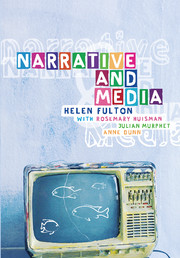Book contents
- Frontmatter
- Contents
- Figures and tables
- Contributors
- Acknowledgements
- 1 Introduction: the power of narrative
- Part 1 The basics of narrative theory
- Part 2 Film as narrative and visual mode
- Part 3 Television: narratives and ideology
- 10 The genres of television
- 11 Television news as narrative
- 12 Aspects of narrative in series and serials
- 13 Soap operas and sitcoms
- Part 4 Radio and print journalism
- Part 5 Popular print culture
- Glossary
- Bibliography
- Index
12 - Aspects of narrative in series and serials
Published online by Cambridge University Press: 05 June 2012
- Frontmatter
- Contents
- Figures and tables
- Contributors
- Acknowledgements
- 1 Introduction: the power of narrative
- Part 1 The basics of narrative theory
- Part 2 Film as narrative and visual mode
- Part 3 Television: narratives and ideology
- 10 The genres of television
- 11 Television news as narrative
- 12 Aspects of narrative in series and serials
- 13 Soap operas and sitcoms
- Part 4 Radio and print journalism
- Part 5 Popular print culture
- Glossary
- Bibliography
- Index
Summary
One understanding of postmodern style is that of fragmentation. What is fragmented, broken up, will depend on what is usually understood to have ‘coherence’ in a particular medium and discourse. In poetry a postmodern style can be read as a dispersal of the unified persona of the traditional lyric; in prose fiction, such as the novel, it could be an incoherence of character, event or setting. (Is that the same character? Has this event already happened? I don't understand!)
The Hollywood tradition of film narrative has on the whole pursued the tight coherence of the nineteenth-century classic realist novel (the American D. W. Griffith, producer and director of the much-studied 1915 film, The Birth of a Nation, was said to have been very influenced by Dickens' novel structure). In comparison, the smaller European markets have allowed more aesthetic freedom. European films offer examples of narrative disruption from the earliest period, from the surreal distortion of setting in the German film The Cabinet of Dr Caligari (1919) to the ambiguity of character and event in the French film, Last Year at Marienbad (1961). For film, greater aesthetic freedom, relative to economic constraints, can favour experimentation, including various types of fragmentation. But in contrast, for television, it is the very economic constraints within which it is produced that oblige the television product to be fragmented in particular ways. These ways have led to the series and the serial being the dominant modes of narration in television.
- Type
- Chapter
- Information
- Narrative and Media , pp. 153 - 171Publisher: Cambridge University PressPrint publication year: 2005



